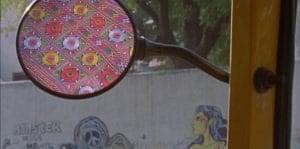
Istanbul’s Grand Bazaar has been around for hundreds of years, and it remains one of the most dynamic and populous centers of commerce in the entire world. Every day, thousands of merchants set up there to sell their wares to hundreds of thousands of customers from across the globe, and the selection of goods on display is so vast that it can appear almost infinite.
Experimental filmmaker Jodie Mack’s short feature The Grand Bizarre cheekily takes its name from that vibrant, teeming marketplace, and the film shares with it a sense of exhilarating vibrancy – but, also, a sort of exhausting, overwhelming abundance. Her work adds up to just about an hour of complete, intentional sensory overload, and, even as it eschews any tangible narrative, it still manages to tell a rather illuminating story about just how much stuff humans create, produce, trade, and – eventually – just sort of cast aside in favor of, well, other stuff.
The basic description of The Grand Bizarre is this: set to a driving, minimalist electronic soundtrack, the film presents what appear to be thousands of different patterned textiles displayed and integrated into the landscape in various settings, using stop-motion and time-lapse techniques to make them continually change from one pattern to the next in a dizzyingly rapid fashion. Juxtaposed with these constantly shifting, multicolored and diversely patterned fabrics are a variety of other objects that reveal similar traits of symmetrical design, repeating patterns, and distinctly planned or engineered qualities: sheet music, tattoos, satellite maps of city blocks, and so on.
“…takes its name from that vibrant, teeming marketplace, and the film shares with it a sense of exhilarating vibrancy…”
Befitting its overseas inspiration, The Grand Bizarre also focuses on travel; some of the key settings into which those textile pieces are incorporated include the cabins of trains and boats, car and motorcycle mirrors, and, often, bustling city streets. What we don’t see a lot of, even in the urban shots, are clear glimpses of people. They’re certainly there, blurrily flitting in and out of the frame for the split-second they’re captured by the time-lapse photography, but there might not be a single legible human face in the entire film. Almost everything on display bears the stamp of human creation, but, throughout, these objects not only represent us – they also largely replace us.
It’s probably fairly obvious, at this point, who this film is for and who it maybe isn’t, but for those with an appreciation for capital-A art cinema, The Grand Bizarre has a lot going on that’s likely to engage on both a sensory and an intellectual level. To describe too many of its more memorable images and juxtapositions would be a disservice to the filmmaker, but a few representative examples are worth a mention. A striking shot, early in the film, frames a suitcase on a beach as the waves crash behind it; with the slight but uncanny jerkiness of stop-motion, disparate strands of eviscerated fabrics emerge from within, as if the piece of luggage has digested and begun to vomit up its contents. That shot is mirrored later on by a similar setup that uses an old-fashioned library card catalog – yet another interesting piece of design and aesthetics that is soon to be forgotten. There’s a lot of interesting play with natural shadows in time-lapse, as well, which several times slowly but unhesitatingly encroach upon and finally overtake the subjects of the frame.
“…forces a viewer to consider how complicated and incredible every single stitch of a rug, or a scarf, or a dishtowel actually is…”
If there’s a complaint about the film, it’s only that it occasionally seems to stall and repeat itself rather than build and crescendo as it often does; these moments might work as palette-cleaners between more dramatic flourishes, but a little goes a long way, there. Of course, The Grand Bizarre sometimes has the opposite problem, also: some of the more interesting things Mack has pointed her camera at are on screen for such a short amount of time that viewers are bound to wish they had more than a few frames within which to appreciate them.
Those minor quibbles, though, are just that, and the overall experience of The Grand Bizarre is, in a lot of ways, an extremely eye-opening one. It forces a viewer to consider how complicated and incredible every single stitch of a rug, or a scarf, or a dishtowel actually is, and how easily it is to overlook that fact. Those objects are inextricably tied to those who create and consume them, and yet, they’re appreciated so incredibly fleetingly, if at all.
What Mack might be asking throughout the film is, are people like that, too?

The Grand Bizarre (2019) Directed by Jodie Mack. The Grand Bizarre screened at the 2019 San Francisco International Film Festival.
7.5 out of 10
